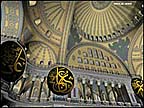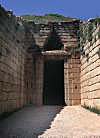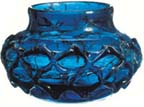
"The earliest Persian garden still tangible, its broken columns rising out of a ruined foundation, was built by Cyrus the Great on a high plain northeast of Shiraz, Iran, at the site where he defeated the Medes in 550 B.C. The garden, divided into four sections by rills, or channels of water, and surrounded by shady pavilions, was not only a refuge in the scorching desert - a paradise on earth - but also an emblem of an empire's power and reach.
'They dropped trenches down to the water table, where melted snow flowed from the mountains,' Ms. Penelope Hobhouse, author of
Gardens of Persia, said. By the fifth century B.C., Persian kings were building gardens fed by aqueducts, which flowed into rills and basins. The Persian word pairidaeza - 'a wall around' - filtered into Greece as paradeisos, which was used to describe the Garden of Eden in the Greek translation of the Bible. Originally, the gardens 'were fenced around to keep out the wind, or marauders or a desert full of evil spirits - the djinns,' Ms. Hobhouse said.
The earliest gardens in Mesopotamia, built in the deltas of the Tigris and Euphrates rivers, are described on cuneiform tablets from around 4000 B.C. They describe how Enki, the Sumerian god of water, provided fresh water to the dry land of Dilmun, transforming it into fields and fruit trees.
This is where the Sumerians dug canals to irrigate their farmland, building the city states Ur and Uruk, Ms. Hobhouse writes.
By 2250 B.C., the Sumerian capital, Babylon, had hunting parks and stepped terraces "constructed to resemble mountains linking earth with heaven," Ms. Hobhouse writes. "There really were hanging gardens in Babylon,'' she said.
See also:
Persian Gardens
If you enjoyed this post, never miss out on future posts by following me by email!
 "A team at the University of Geneva have developed virtual reality models of two Turkish mosques dating from the Ottoman era of the 16th century which let you move around and explore the buildings in real-time. For the project, the Miralab team focused on the mosques of Aya Sofya and Hagia Sophia. As well as the buildings, they also created virtual humans, including an imam, to simulate what Friday prayers would have been like in the Ottoman era.
"A team at the University of Geneva have developed virtual reality models of two Turkish mosques dating from the Ottoman era of the 16th century which let you move around and explore the buildings in real-time. For the project, the Miralab team focused on the mosques of Aya Sofya and Hagia Sophia. As well as the buildings, they also created virtual humans, including an imam, to simulate what Friday prayers would have been like in the Ottoman era.
 "A subterranean
"A subterranean  "The discovery of an Anglo-Saxon king's burial chamber complete with a lavish collection of treasures was more than any archaeologist would hope to find beneath a verge in the Southend suburb. Described yesterday as 'a once in a lifetime discovery' it is hoped the chamber in Essex will provide a unique insight into life and death in the Dark Ages."
"The discovery of an Anglo-Saxon king's burial chamber complete with a lavish collection of treasures was more than any archaeologist would hope to find beneath a verge in the Southend suburb. Described yesterday as 'a once in a lifetime discovery' it is hoped the chamber in Essex will provide a unique insight into life and death in the Dark Ages."
 "The earliest Persian garden still tangible, its broken columns rising out of a ruined foundation, was built by Cyrus the Great on a high plain northeast of Shiraz, Iran, at the site where he defeated the Medes in 550 B.C. The garden, divided into four sections by rills, or channels of water, and surrounded by shady pavilions, was not only a refuge in the scorching desert - a paradise on earth - but also an emblem of an empire's power and reach.
"The earliest Persian garden still tangible, its broken columns rising out of a ruined foundation, was built by Cyrus the Great on a high plain northeast of Shiraz, Iran, at the site where he defeated the Medes in 550 B.C. The garden, divided into four sections by rills, or channels of water, and surrounded by shady pavilions, was not only a refuge in the scorching desert - a paradise on earth - but also an emblem of an empire's power and reach.